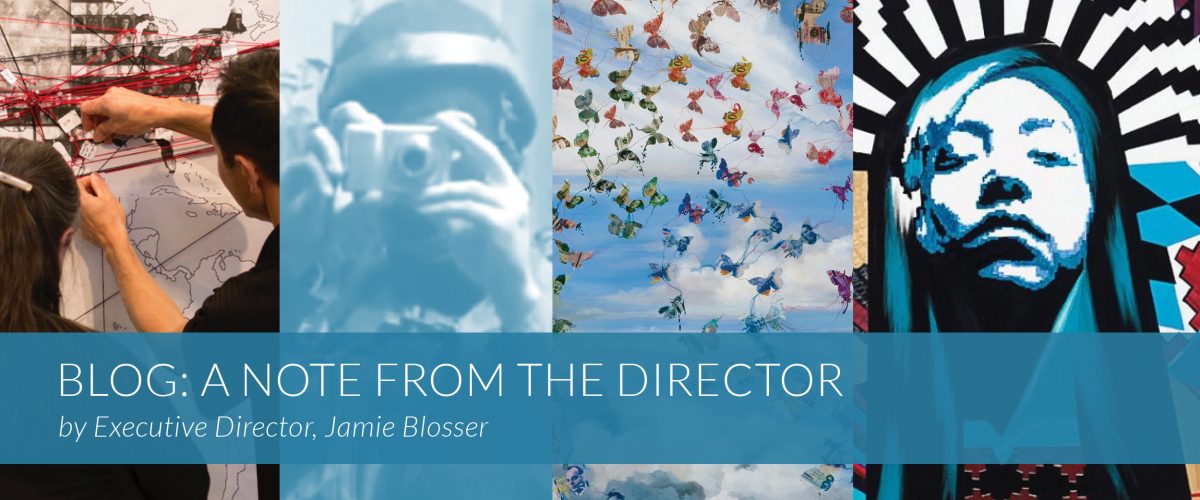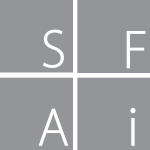
Sometimes current events, even local events, can feel massively abstract, and their reverberations in our lives can feel tiny, inconsequential. And sometimes events, though thousands of miles away, can feel devastatingly relevant and even heartbreaking.
As I write this, Brett Kavanaugh was confirmed to the Supreme Court by a Senate vote of 50-48. Though this is not what I intend to write about, I want to put this — or any number of current events creating headlines each day — in the context of why SFAI does what we do, and why supporting the arts is critical for all of us to participate in the ebb and flow of progress toward a truly equitable society.
SFAI launched our current theme, Truth & Reconciliation, in September. We chose this theme because we believe that truth in service of reconciliation is a deeply creative act that can help to heal our divisions and re-imagine a better world. Seeking truth requires peeling back many layers – and courageously looking at who we are as individuals, institutions, communities, and nations.
Truth & Reconciliation is not an easy theme. It requires significant reflection and action, and the seed of this theme grew from SFAI’s decision to re-evaluate our own institutional barriers to access and diversity. In 2017, SFAI eliminated tuition for our international Thematic Residency Program, and this year we established Story Maps, a fellowship for local, emerging artists of color to engage in issues of equity and equality within our civic systems. We have partnered with the U.S. Department of Arts and Culture on their #HonorNativeLand initiative and are learning as a community to model our core values of inclusion, transparency, collaboration, compassion, and responsibility. These are not initiatives that can simply be pronounced and then left to collect dust on a metaphorical shelf – they require constant reflection, conversation, learning, and sometimes discomfort. It is an iterative process that is required to shift a 33-year-old institution toward the creative discourse necessary in this new millennium.
In the midst of this internal work, SFAI faces external opportunities and challenges with the closure of the Santa Fe University of Art and Design last June. We are located on the Midtown Campus because of the generosity of John and Ann Marion and others, who stepped in with support when SFAI leadership was seeking a permanent home in the 1990’s. The vision of that leadership, in partnership with the (then) College of Santa Fe, was to create an arts and education hub in Midtown Santa Fe. This vision and partnership resulted in not only a permanent home for SFAI on the campus, but the development of the Visual Arts Center, designed by world-renowned Mexican architect, Ricardo Legorreta.
SFAI seeks to maintain and strengthen our original legacy on the Midtown Campus. Yet, there is some truth and reconciliation required to imagine its highest potential. Those of us in Santa Fe need to come to terms with its history as a beloved but cloistered campus, and how its separation from adjacent neighborhoods, some of which are the poorest in Santa Fe, have contributed to Midtown sprawl and disinvestment. We believe that many different uses are possible and desirable on the campus as a new Midtown District, including much-needed housing. Yet it is important to maintain the legacy of arts and education for the benefit of the local community. We see an opportunity for local and regional arts, education, and social service organizations to work together in developing a vibrant hub at the Visual Arts Center, that would serve Midtown Santa Fe and all of Northern New Mexico, as well as attract national and international investment and support. This is a game-changing opportunity to strengthen the work we already do at SFAI, and we seek partners willing to collaborate on making this a reality.
Artists and creatives may or may not change the course of politics or solve critical global issues. But they are uniquely qualified to witness, question, and challenge truth in order to reconcile our collective wickedness and beauty, suffering and joy, legacy and impermanence. Through 2019, SFAI will host over 70 artists and creative practitioners of all disciplines, including 18 local, 47 national, and 22 international artists from over 22 countries, 19 U.S. states, and 13 sovereign tribal nations. Over 60% of them are people of color and 70% identify as women. We will curate and host over 20 events in the next year, free and open to the public, to elevate these voices that are not often heard – or believed.
I hope that you see, as I do, that these diverse perspectives and works bolster our spirit, connect us, and provide a foundation for the collective and difficult work of moving toward the emerging new world.
You will hear from me in the coming months asking for your support, so that SFAI may continue to ensure this important work is as accessible and diverse as possible. Please reach out to me with questions. I always love to talk about the exciting work of our artists, staff, and board.
Thank you all for the good work you do in the world, and for continuing to support SFAI.

 © Santa Fe Art Institute / Santa Fe, New Mexico /
© Santa Fe Art Institute / Santa Fe, New Mexico /